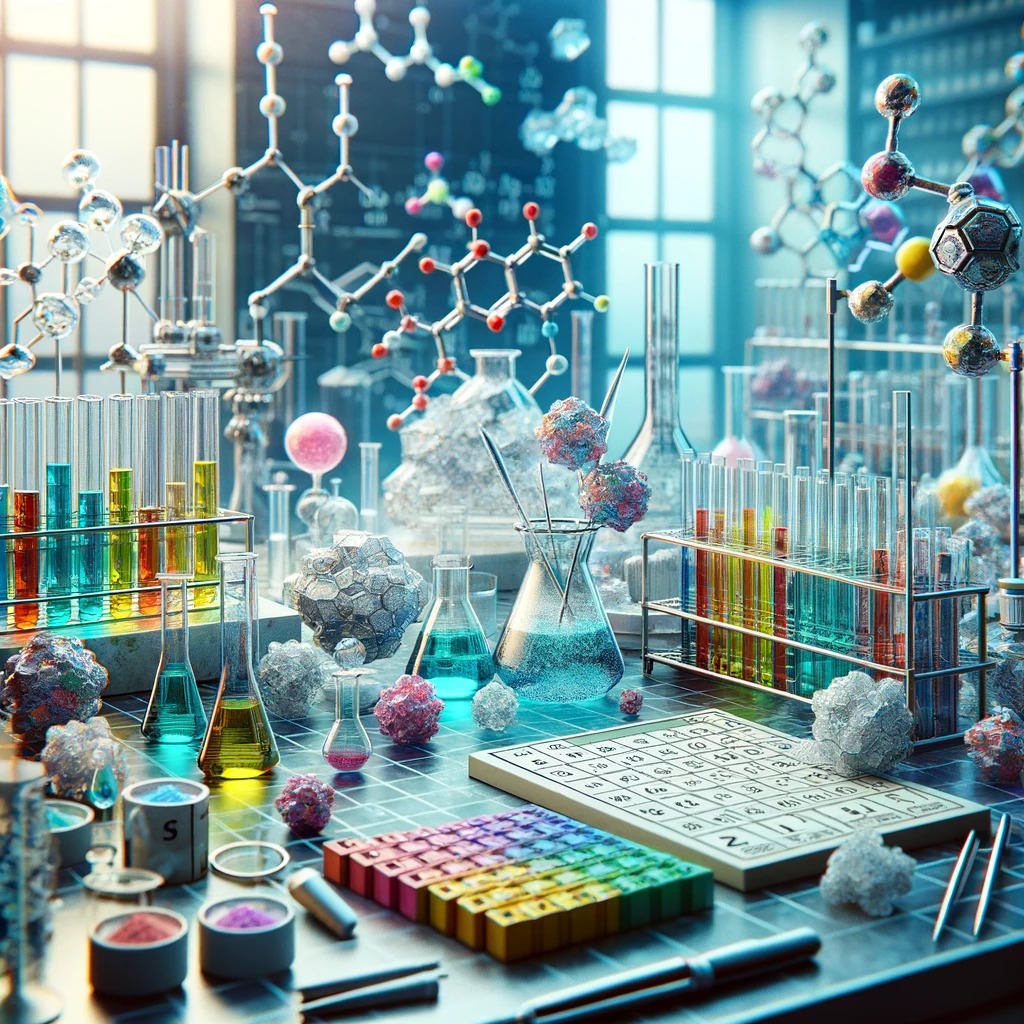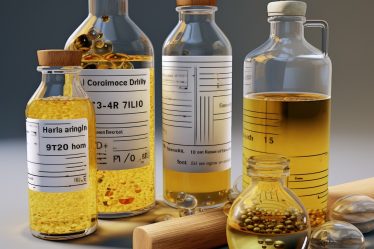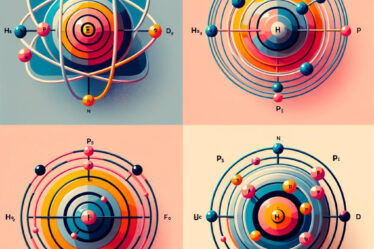
Explore the fundamentals of inorganic chemistry, the branch of science dedicated to studying a diverse range of non-organic compounds. This field encompasses all chemicals and reactions not involving carbon-hydrogen bonds, from essential minerals and metals to the critical catalysts facilitating industrial chemical processes. Delve into studying elements across the periodic table as you learn their roles in forming everything from sturdy materials to life-sustaining enzymes.
Here’s a Glimpse of What You’ll Learn:
- The core inorganic chemistry definition and how it differs from organic chemistry.
- Diverse inorganic chemistry examples and their applications in daily life.
- Insight into the chemical reactions that characterize inorganic substances.
- Tips on navigating the complexities and understanding how hard inorganic chemistry can be.
- The intersection of inorganic chemistry with materials science and engineering in technology.
- A curated list of inorganic chemistry books and online resources for deepening your knowledge.
- Quick, accessible answers to common queries in our Chemistry FAQs section.
Are you interested in other subjects? Read top free study guides for Biology, English, French, and Music.
Inorganic Chemistry Fundamentals: A Comprehensive Guide
Definition of Inorganic Chemistry: Core Concepts
Inorganic chemistry is the branch of science focused on the properties and behavior of inorganic compounds—those that do not include carbon-hydrogen bonds. Unlike organic compounds, these substances can range from simple salts like sodium chloride to complex minerals in the earth’s crust. This field encompasses not only various chemicals found naturally on Earth but also numerous artificial substances. With a fundamental role in diverse industries, inorganic chemistry influences advancements in medicine, technology, and environmental sustainability .
Inorganic vs. Organic Chemistry: Key Differences
Distinguishing inorganic chemistry from organic chemistry hinges on the types of compounds they study. Organic chemistry exclusively investigates carbon-containing compounds, whereas inorganic chemistry deals with the remaining elements of the periodic table. This division is not absolute, as some compounds, such as organometallics, blur the lines between the two with their metal-carbon bonds. Understanding this difference is crucial for students as it shapes the approach to studying chemical reactions, bonding, and applications in real-world scenarios.
Detailed Comparison: Inorganic vs Organic Chemistry
- Bonding: Organic compounds primarily exhibit covalent bonding, with a focus on carbon-hydrogen bonds. Inorganic chemistry, however, encompasses a broader range of bonding types, including ionic, metallic, and hydrogen bonding.
- Complexity of Molecules: Organic molecules can be quite complex, with intricate chains and rings, whereas inorganic molecules are often simpler but can form complex structures like coordination complexes.
- Melting and Boiling Points: Organic compounds generally have lower melting and boiling points. In contrast, inorganic compounds, particularly ionic salts, have higher melting and boiling points due to strong ionic bonds.
- Reactivity: Organic chemistry reactions are diverse, including additions, substitutions, and eliminations, primarily involving the reactivity of carbon. Inorganic reactions can be driven by the reactivity of a wide range of elements and often involve redox processes.
- Occurrence in Nature: Organic compounds are central to life, forming the basis of biochemistry. Inorganic compounds are abundant in the Earth’s crust and are involved in geological and atmospheric processes .
| Aspect of Organic Chemistry | Aspect of Inorganic Chemistry |
|---|---|
| Carbon-hydrogen bonds as a fundamental component | Elements beyond carbon, including metals and gases |
| Complex molecular structures with covalent bonding | Simpler structures, often ionic, but also includes complex coordination chemistry |
| Lower melting and boiling points relative to inorganic compounds | Typically higher melting and boiling points |
| Foundational for biochemistry and pharmaceuticals | Essential for industrial processes, catalysis, and materials science |
| Reactions often involve the formation or breaking of C-H bonds | Reactions include a wide range of chemical processes, such as redox and acid-base reactions |
Inorganic Compounds: Daily Significance and Industrial Impact
Everyday Encounters with Inorganic Chemistry
Unseen yet ubiquitous, inorganic compounds are cornerstones of modern living. The chlorine in tap water ensures safety, the lithium in batteries powering devices, and even the phosphates in detergents breaking down stains—all are inorganic. Their presence across various household items underlines inorganic chemistry’s role in daily conveniences and necessities.
Inorganic Compounds in Industry
In industry, inorganic chemistry catalyzes innovation. It develops aerospace superalloys, renewable energy photovoltaic cells, and electronic materials. Inorganic catalysts are crucial for refining petroleum, and inorganic materials are foundational in construction. These applications demonstrate the critical role of inorganic chemistry in economic and technological progress.
Chemical Reactions in Inorganic Chemistry
Understanding Ionic and Covalent Bonds in Inorganic Chemistry
The stability and reactivity of inorganic compounds are often dictated by ionic and covalent bonds . Ionic bonds form between metals and non-metals as electrons transfer, creating ions that attract each other. Covalent bonds, conversely, involve the sharing of electrons between non-metal atoms. These bonding types give rise to the diverse properties and applications of inorganic substances, from the solidity of ionic salts to the volatility of covalent gases.
- Ionic Bonds: Formation in compounds like magnesium oxide (MgO), where electrons transfer from magnesium to oxygen.
- Covalent Bonds: Found in molecules like nitrogen gas (N2), where two nitrogen atoms equally share three pairs of electrons.
Redox Reactions: The Driving Force in Inorganic Processes
Redox reactions, where one substance donates electrons (reduction) and another accepts electrons (oxidation), are central to inorganic chemistry. These processes are crucial for energy production in batteries, metal extraction, and biological systems like photosynthesis. A firm grasp of redox principles is essential for understanding how these reactions shape the natural and industrial worlds.
- Oxidation: Often involves the addition of oxygen or the loss of hydrogen, as seen when iron rusts.
- Reduction: Typically entails the loss of oxygen or gain of hydrogen, crucial in processes like metal refining.
The basics of Polymers and PET plastic.
Complexities of Inorganic Chemistry: A Student’s Perspective
How Hard is Inorganic Chemistry and How to Navigate Its Challenges
Inorganic chemistry can seem daunting with its wide range of concepts and unpredictable reactions. The key to mastering this complexity lies in a systematic study approach, starting from fundamental principles and progressing to more complex topics. Understanding the periodic table and the types of chemical bonds sets a solid foundation for deeper exploration.
The Importance of Tutoring in Mastering Inorganic and Organic Chemistry
Personalized tutoring can be a game-changer in comprehending inorganic chemistry’s intricacies. A tutor offers tailored explanations and can simplify complex ideas, making them more accessible. Moreover, tutoring provides an interactive learning environment, encouraging questions and active problem-solving, which is invaluable for grasping challenging concepts.
Are you looking for a chemistry tutor? Enter “chemistry tutor Glasgow” or “chemistry teacher Sheffield” on your preferred tutoring platform, such as meet’n’learn, to find a teacher who can meet your specific needs.
If you thrive in group learning environments, search “chemistry classes London” or “chemistry lessons Manchester” online to discover local schools offering chemistry lessons.
Chemistry Study Tips and Resources
Success in inorganic chemistry often requires utilizing various study resources. From textbooks like “Inorganic Chemistry” by Shriver & Atkins to online platforms offering interactive simulations, there’s a wealth of information available. Regular practice, joining study groups, and leveraging digital resources can significantly enhance understanding and retention of inorganic chemistry principles.
Introduction to Proteins, Amino Acids, Peptide Bonds, and Enzymes.
Applications of Inorganic Chemistry in Modern Technology
Inorganic Chemistry in Materials Science and Engineering
Inorganic chemistry plays a pivotal role in materials science and engineering, where it aids in the development of new materials with specific properties. Inorganics provide the basis for semiconductors, superconductors, and photovoltaic cells, essential in electronics and renewable energy sectors. Understanding the properties of inorganic compounds allows engineers to innovate in the creation of stronger alloys, more efficient batteries, and advanced building materials.
Inorganic Elements in Energy and Sustainability
The contribution of inorganic elements to energy and sustainability is significant. Inorganic compounds are at the forefront of developing clean energy technologies, such as fuel cells and hydrogen storage. They are also crucial in water purification processes and air pollution control, contributing to a more sustainable future. As we advance towards eco-friendly practices, the role of inorganic chemistry continues to expand, offering solutions to some of the most pressing environmental challenges.
Continuing Education in Inorganic and Organic Chemistry
Top Inorganic Chemistry Books for Further Learning
For those seeking to deepen their knowledge, a selection of inorganic chemistry books stands out. “Inorganic Chemistry” by Miessler, Fischer, and Tarr offers comprehensive insights, while “Descriptive Inorganic Chemistry” by Rayner-Canham and Overton provides a more approachable take. Students and tutors can benefit from the detailed explanations and real-world context these resources offer.
Online Resources and Courses for Chemistry
Online platforms have revolutionized learning, providing interactive and flexible educational opportunities. Websites like Coursera and Khan Academy offer inorganic chemistry courses that cover basic to advanced concepts. These resources are invaluable for those who prefer self-paced learning or need supplementary material to grasp complex topics.
We also suggest you visit our World of Chemistry, where you will find a plethora of free educational blogs.
Our Tips for Learning Inorganic Chemistry
- Continue exploring more complex topics like hydroxides and halogenides.
- Engage in chemistry classes or private tutoring lessons to deepen your practical understanding.
Conclusion: Chemistry and Personalized Learning
Mastering inorganic chemistry is vital for students and professionals. A chemistry tutor can provide personalized attention that deepens understanding, while tutoring and private classes offer more tailored learning experiences. These educational approaches equip learners with the knowledge to excel in this rigorous scientific field and apply it practically in various sectors.
Inorganic Chemistry FAQs
1. What is Inorganic Chemistry?
Inorganic chemistry focuses on substances that are not organic, mainly involving non-carbon-based compounds, including metals, minerals, and organometallics.
2. How does Inorganic Chemistry differ from Organic?
While organic chemistry deals with carbon-containing compounds, inorganic chemistry studies the rest of the chemical compounds in the periodic table.
3. Can you give examples of Inorganic Compounds?
Common examples include water (H2O), table salt (NaCl), and baking soda (NaHCO3).
4. Why is Inorganic Chemistry important?
It’s essential for understanding fundamental processes in nature and for applications in industries like pharmaceuticals, materials science, and energy.
5. What are some common reactions in Inorganic Chemistry?
Typical reactions include redox, acid-base, and precipitation reactions.
6. How can I excel in Inorganic Chemistry?
Master the basics, practice problem-solving, and understand the periodic table’s trends and properties.
7. Where can Inorganic Chemistry be applied in real life?
It’s used in water treatment, electronics, catalysis, and more.
8. What resources are best for learning Inorganic Chemistry?
Quality textbooks, online courses, and academic journals are excellent resources.
Need help with biology topics? Explore our extensive collection of biology educational blog posts designed to simplify complex concepts for you. Whether it’s photosynthesis, osmosis, the intricacies of green algae, understanding bacteria and viruses, or delving into the fascinating world of genetics and cells, our resources have got you covered. Expand your knowledge and enhance your learning journey with us today.
References:
1. ThoughtCO
2. Britannica
3. Wikipedia



